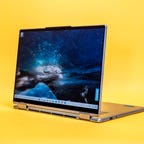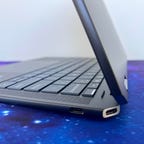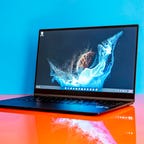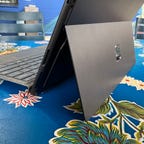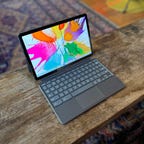Best 2-in-1 Laptop for 2024
Looking for a device that can be used as a laptop or tablet? These are our top picks for the best two-in-one options.
What to consider
Price
Statistically, you’ll hold onto your next laptop for at least three years. The current sweet spot for a reliable laptop to handle average work, home office or school tasks is between $700 and $800 and a reasonable model for creative work or gaming is upwards of about $1,000. The key is to look for discounts on models in all price ranges to get the best configuration you can for your money.
Operating system
For a two-in-one, you have a choice between Microsoft Windows and Google’s ChromeOS. The majority of two-in-ones feature Windows 11, but if you are on a tight budget, consider a convertible Chromebook after learning about its limitations.
Size
With a two-in-one, you have to find the balance between being big enough to be useful in laptop mode and compact enough to be manageable in tablet mode. An 16-inch model that might be attractive as a laptop, for example, could feel unwieldy to you as a tablet. Size is primarily determined by the display, which in turn factors into battery size, laptop thickness and weight.
Screen
Do you want a larger laptop with a bigger screen on which to work or play? Or is having a thinner and lighter and more portable laptop more important? Higher resolutions are better for fitting more on a screen and look for a dot pitch of at least 100 pixels per inch (ppi) as a rule of thumb.
Processor
The processor, aka the CPU, is the brains of a laptop. Intel and AMD are the main CPU makers for Windows laptops with a staggering selection between them. Generally, though, the faster the processor speed and the more cores it has, the better the performance will be.
Memory
We highly recommend 16GB of RAM, with 8GB being the absolute minimum. RAM is where the operating system stores all the data for currently running applications, and it can fill up fast. After that, it starts swapping between RAM and the storage drive, which is slower.
Graphics
For Windows laptops, there are two types of GPUs: integrated (iGPU) or discrete (dGPU). Because the iGPU splits space, memory and power with the CPU, it's better for smaller, lighter laptops, but doesn't perform nearly as well as a dGPU. For things like video editing, gaming, design and so on, you'll need a dGPU.
Storage
Solid-state drives (SSDs) can make a big difference in how fast performance feels compared with older and slower spinning-disk hard drives. But not all SSDs are equally speedy and cheaper laptops typically have slower drives. If you need to go with a smaller drive, you can always add an external drive or two or use cloud storage to bolster a small internal drive.
Our Picks
There are times when you want to switch between a laptop and a tablet but detest having to lug both items around with you. If you often find yourself in this situation, a two-in-one device is perfect for you. These machines offer the best of both worlds. The best two-in-one laptops are extremely versatile and allow you to do far more than a traditional laptop, and all without a large increase in price, weight or size.
The best-rated two-in-one devices tend to be convertible laptops that feature 360-degree hinges where the keyboard and trackpad rotate around to the back of the display. There are also some excellent two-in-one laptops that are essentially Windows 11 or ChromeOS tablets with a detachable keyboard. Admittedly, these tend to work best as tablets but are still easy-to-use when in laptop mode.
We’ve put a number of devices to the test and we can reveal that these are the best two-in-one laptops 2024 has to offer.
Read more: Best Laptop for 2024
This thin, 3-pound convertible is a solid choice for anyone who needs a laptop for office or schoolwork. The all-metal chassis gives it a premium look and feel, and it has a comfortable keyboard and a responsive, smooth precision touchpad. Though it's light on extra features compared to its premium linemate, the Yoga 9i, it does have one of Lenovo's sliding shutters for its webcam that gives you privacy when you want it. And it has a long battery life to boot at 12 hours, 45 minutes in our tests. The latest version with 13th-gen Intel processors starts at less than $1,000.
Best premium 2-in-1
HP Spectre x360 14
We don't make it a practice to recommend laptops that cost nearly $2,000 that rely on integrated graphics. At this price, it's reasonable to expect a dedicated GPU for gaming or content creation. The Spectre x360 14, however, is the rare exception. This two-in-one is one of the first laptops to feature Intel's new Core Ultra CPU that delivers solid performance today and is equipped for the AI workloads of the future. Plus, those graphics integrated to the Core Ultra processor are an improvement on Intel’s previous-generation iGPU. The all-metal, matte-black chassis is as stunning as the high-res OLED display. And the 9-megapixel webcam is awesome, especially when combined with the AI-assisted Windows Studio Effects and noise reduction features.
With its next-gen Intel Core Ultra CPU, gorgeous OLED display and premium build quality, the Spectre x360 14 is primed for a long and useful life and delivers value, even at its elevated price.
Best 15.6-inch 2-in-1
Samsung Galaxy Book 2 Pro 360
Samsung's 16:9 big-screen two-in-one doesn't look all too different from its predecessor, but inside is a 12th-gen Intel processor that gives it a sizable multicore performance bump. However, the other, smaller updates Samsung made to the Pro 360 improves the overall experience, making it one of the best two-in-ones available, even more than a year after its release. And if you have other Galaxy devices, this is absolutely the two-in-one to get. Well, other than the larger 16-inch version anyway.
If you are willing to spend more, the latest Galaxy Book 3 Pro 306 starts at $1,500 and supplies 13th-gen Intel silicon and a larger (16-inch) and higher-res (3K) AMOLED display.
Best detachable 2-in-1
Microsoft Surface Pro 8
The Surface Pro continues to hit all the right notes if you're looking for a do-it-all Windows tablet that doubles as a Windows laptop. Microsoft has since updated it for the Surface Pro 9, but little has changed beyond a processor upgrade from 11th-gen Intel Core processors to 12th-gen chips as well as an option for a Microsoft SQ 3 processor with 5G wireless. If you were contemplating a Pro 8, it's still around but now with a lower price, and we recommend it for most people instead of the Surface Pro 9.
We also like the Dell XPS 13 2-in-1 as a lower-cost, detachable convertible, but Dell has yet to master the kickstand and the keyboard cover as well as Microsoft has for its Surface Pros.
Best detachable 2-in-1 Chromebook
Lenovo Duet Chromebook
The Lenovo Duet Chromebook (aka Chromebook Duet 3) is an awesome little 11-inch ChromeOS tablet with a detachable keyboard and touchpad. Its small size and performance aren't ideal for full-time use. But the Chromebook Duet 3 is a good pick if you're looking for an affordable ultraportable device to get some work done on the go, sketch or jot down notes in class, or do simple stuff like email, web browsing, gaming, reading and streaming video.
Best 2-in-1 convertible Chromebook
Acer Chromebook Spin 714
Acer had one of the best Chromebooks available in 2021 with the Spin 713, and now it's repeated that success with the Chromebook Spin 714. The premium two-in-one doesn't stray far from its predecessor in terms of what it offers -- sturdy design, nice-looking display, strong performance and long battery life -- but Acer did make some changes to keep it competitive, like including a USI pen that stores and charges in the 714's body. There are less expensive options, but if you want a Chromebook that'll last for years, this is it. Keep an eye out for a sale on this one: Its normal price is $729, but can oftentimes be found on sale for less than $600.
Best 2-in-1 for gaming
Asus ROG Flow X16
Gaming laptops with 16-inch screens are common enough. What's unusual is finding one with a 360-degree hinge to become a foldable two-in-one that can be a laptop, a tablet and a couple of things in between. Add another level of ingenuity and you've got the ability to plug in a more-powerful external GPU for even better performance. It's expensive, to be sure, but the unique design and features as well as solid performance make it stand out.
We reviewed the previous-generation model with GeForce RTX 3060 graphics, and the line has since been updated with RTX 4060 and 4070 GPUs. The current baseline model with a Core i9-13900H CPU and RTX 4060 graphics costs $1,850.
Best 2-in-1 for creatives
HP Spectre x360 16
The HP Spectre x360 16 doesn't have "pro" in its name, but it deserves to. It's not a business laptop, so you won't find an Intel vPro processor or IT management features. However, its premium features, beautiful OLED display, good looks and speedy performance are just about perfect for anyone looking for a versatile laptop with an awesome work-play-and-create design.
The design hasn't changed much since we reviewed it, but it now features up to a 2.8K OLED display instead of a 4K panel. And that's not necessarily a bad move; a 2.8K resolution still looks sharp on a 16-inch screen while taxing the battery less. And like the 14-inch model we recently reviewed, the Spectre x360 16 now offers Intel Core Ultra processors along with the latest Nvidia GPUs.
How we test laptops
The review process for laptops consists of two parts: performance testing under controlled conditions in the CNET Labs and extensive hands-on use by our reviewers. This includes evaluating a device's aesthetics, ergonomics and features with respect to price. A final review verdict is a combination of both objective and subjective judgments.
We test all laptops with a core set of benchmarks, including Primate Labs Geekbench 5 and 6, Cinebench R23, PCMark 10, a variety of 3DMark benchmarks (whichever can run on the laptop), UL Procyon Photo and Video (where supported) and our own battery life test. If a laptop is intended for gaming, we'll also run benchmarks from Guardians of the Galaxy, The Rift Breaker (CPU and GPU) and Shadow of the Tomb Raider.
For the hands-on, the reviewer uses it for their work during the review period, evaluating how well the design, features (such as the screen, camera and speakers) and manufacturer-supplied software operate as a cohesive whole. We also place importance on how well they work given their cost and where the manufacturer has potentially made upgrades or tradeoffs for its price.
The list of benchmarking software and comparison criteria we use changes over time as the devices we test evolve. You can find a more detailed description of our test methodology on our How We Test Computers page.
Other laptops we've tested
Acer Swift Go 14 (2024): Intel's new Core Ultra CPU gives this unassuming 14-inch laptop great battery life and a bit of a speed boost -- with potential AI acceleration down the road.
MSI Modern 14 C13M: Its audio-visual output won't wow you, but MSI's 14-inch budget offering boasts good build quality and competitive performance.
HP Dragonfly G4: HP's compact premium business laptop stands out with its unusual 3:2 display and unique dual-webcam capability.
Acer Swift Edge 16 (2023): It's the rare 16-inch laptop that weighs less than 3 pounds. And the OLED display is awesome.
Dell XPS 13 Plus (2023): An unconventional ultraportable gets a minor update.
Apple MacBook Pro 14 (Late 2023): The M3-based models don't seem especially good buys, but the M3 Pro choices should deliver.
Apple MacBook Pro 16 (M3, Late 2023): Apple's high-end MacBook Pro gets faster -- a lot in some respects -- and darker.
Acer Swift Go 16: It’s a good choice for those who want a big-screen laptop with productivity power, but it gets lost between Acer's own 16-inch Swift X and Swift Edge laptops.
Dell Inspiron 16 Plus 7630: Dell's more budget-friendly content-creation laptop offers powerful discrete graphics and a large, 16-inch panel with an improved 120Hz refresh rate, but I still want some display upgrade options.
Asus Zenbook S 13 OLED (UX5304): Want a quick little laptop for getting work done anywhere? We strongly recommend giving Asus' ultralight 13-inch OLED laptop a look
Lenovo ThinkPad X1 Carbon Gen 11: The latest X1 Carbon gets 13th-gen Intel processors and greener construction but is otherwise unchanged and remains a top pick for business travelers.
HP Spectre Foldable PC: It's slick but quirky. And it costs.
HP Dragonfly Pro Chromebook: It’s the premium Chromebook to beat.
Lenovo Yoga 7i 16: The 14-inch Yoga 7i has long been a favorite for offering more for less. The "more" on this version includes a 16-inch display with a low resolution that makes text fuzzy, and it's an awkward size for a two-in-one.
Factors to consider
There are a ton of two-in-one laptops on the market at any given moment, and almost all of those models are available in multiple configurations to match your performance and budget needs. So if you're feeling overwhelmed with options when looking for a new two-in-one, it's understandable. To help simplify things for you, here are the main things you should consider when you start looking.
Price
The search for a new two-in-one for most people starts with price. If the statistics chipmaker Intel and PC manufacturers hurl at us are correct, you'll be holding onto your next laptop for at least three years. If you can afford to stretch your budget a little to get better specs, do it. And that stands whether you're spending $500 or more than $1,000. In the past, you could get away with spending less upfront with an eye toward upgrading memory and storage in the future. But laptop makers are increasingly moving away from making components easily upgradable, so again, it's best to get as much two-in-one laptop as you can afford from the start.
Generally speaking, the more you spend, the better the two-in-one. That could mean better components for faster performance, a nicer display, sturdier build quality, a smaller or lighter design from higher-end materials or even a more comfortable keyboard. All of these things add to the cost of a laptop. Right now, the sweet spot for a reliable two-in-one that can handle average work, home office or school tasks is between $700 and $800 and a reasonable model for creative work or gaming upwards of about $1,000. The key is to look for discounts on models in all price ranges so you can get more of what you want for less.
Operating system
Choosing an operating system is part personal preference and part budget. For a two-in-one, you have a choice between Microsoft Windows and Google’s ChromeOS. (Apple has yet to merge its MacBook laptops and iPad tablets into a convertible device.)
The majority of two-in-ones feature Windows, but if you are on a tight budget, consider a Chromebook. ChromeOS is a different experience than Windows; make sure the applications you need have a Chrome, Android or Linux app before making the leap. But if you spend most of your time roaming the web, writing, streaming video or using cloud-gaming services, they're a good fit.
Size
With a two-in-one, you have to find the balance between being big enough to be useful in laptop mode and compact enough to be manageable in tablet mode. An 16-inch model that might be attractive as a laptop could feel unwieldy to you as a tablet. On the flip side, an 11-inch tablet might be the perfect entertainment device but will likely feel cramped in laptop mode for getting work done.
Size is primarily determined by the screen -- hello, laws of physics -- which in turn factors into battery size, laptop thickness, weight and price. And keep in mind other physics-related characteristics, such as an ultrathin laptop isn't necessarily lighter than a thick one, you can't expect a wide array of connections on a small or ultrathin model and so on.
Screen
When it comes to deciding on a screen, there are a number of considerations: how much you need to display (which is surprisingly more about resolution than screen size), what types of content you'll be looking at and whether or not you'll be using it for gaming or creative work.
You really want to optimize pixel density; that is, the number of pixels per inch the screen can display. Though there are other factors that contribute to sharpness, a higher pixel density usually means sharper rendering of text and interface elements. (You can easily calculate the pixel density of any screen at DPI Calculator if you don't feel like doing the math, and you can also find out what math you need to do there.) We recommend a dot pitch of at least 100 pixels per inch as a rule of thumb.
Because of the way Windows and ChromeOS scale for the display, you're frequently better off with a higher resolution than you'd think. You can always make things bigger on a high-resolution screen, but you can never make them smaller -- to fit more content in the view -- on a low-resolution screen. This is why a 4K, 14-inch screen may sound like unnecessary overkill, but may not be if you need to, say, view a wide spreadsheet.
If you need a laptop with relatively accurate color, that displays the most colors possible or that supports HDR, you can't simply trust the specs -- not because manufacturers lie, but because they usually fail to provide the necessary context to understand what the specs they quote mean. You can find a ton of detail about considerations for different types of screen uses in our monitor buying guides for general purpose monitors, creators, gamers and HDR viewing.
Processor
The processor, aka the CPU, is the brains of a laptop. Intel and AMD are the main CPU makers for Windows laptops. Both offer a staggering selection of mobile processors. Making things trickier, both manufacturers have chips designed for different laptop styles, like power-saving chips for ultraportables or faster processors for gaming laptops. Their naming conventions will let you know what type is used. You can head to Intel's or AMD's sites for explanations so you get the performance you want. Generally speaking, though, the faster the processor speed and the more cores it has, the better the performance will be.
Because the lightweight ChromeOS is less demanding than Windows, you don’t need as powerful a CPU to get a smooth experience, which is one reason why Chromebook convertibles are more affordable than Windows-based two-in-ones.
Graphics
The graphics processor (GPU) handles all the work of driving the screen and generating what gets displayed, as well as speeding up a lot of graphics-related (and increasingly, AI-related) operations. For Windows two-in-one laptops, there are two types of GPUs: integrated (iGPU) or discrete (dGPU). As the names imply, an iGPU is part of the CPU package, while a dGPU is a separate chip with dedicated memory (VRAM) that it communicates with directly, making it faster than sharing memory with the CPU.
Because the iGPU splits space, memory and power with the CPU, it's constrained by the limits of those. It allows for smaller, lighter designs but doesn't perform nearly as well as a dGPU. In fact, there are some games and creative software that won't run unless they detect a dGPU or sufficient VRAM. Most productivity software, video streaming, web browsing and other non-specialized apps will run fine on an iGPU, though.
For more power-hungry graphics needs, like video editing, gaming and streaming, design and so on, you'll need a dGPU; there are only two real companies that make them, Nvidia and AMD, with Intel offering some based on the Xe-branded (or the older UHD Graphics branding) iGPU technology in its CPUs.
Memory
For memory, we highly recommend 16GB of RAM (8GB absolute minimum). RAM is where the operating system stores all the data for currently running applications, and it can fill up fast. After that, it starts swapping between RAM and SSD, which is slower. A lot of sub-$500 laptops have 4GB or 8GB, which in conjunction with a slower disk can make for a frustratingly slow Windows laptop experience. Also, many two-in-ones now have the memory soldered onto the motherboard. Most manufacturers disclose this, but if the RAM type is LPDDR, assume it's soldered and can't be upgraded.
However, some PC makers will solder memory on and also leave an empty internal slot for adding a stick of RAM. You may need to contact the laptop manufacturer or find the laptop's full specs online to confirm. And check the web for user experiences, because the slot may still be hard to get to, it may require nonstandard or hard-to-get memory or other pitfalls.
Storage
You'll still find cheaper hard drives in budget models, but faster solid-state drives (SSDs) have all but replaced traditional hard drives in two-in-one laptops. They can make a big difference in performance. But not all SSDs are equally speedy, and cheaper laptops typically have slower drives; if the laptop only has 4GB or 8GB of RAM, it may end up swapping to that drive and the system may slow down quickly while you're working.
Get what you can afford, and if you need to go with a smaller drive, you can always add an external drive or two down the road or use cloud storage to bolster a small internal drive.
Laptop FAQs
How much do good laptops cost?
Setting a budget is a good place to start when shopping for the best laptop for yourself. The good news is you can get a nice-looking, lightweight laptop with excellent battery life at prices under $500. If you're shopping for a laptop around $500 or less, check out our top picks here, as well as more specific buying advice for that price range.
Higher-end components like Intel Core i-series and AMD Ryzen processors and premium design touches like thin-display bezels and aluminum or magnesium bodies have made their way to laptops priced between $500 and $1,000. You can also find touchscreens and two-in-one designs that can be used as a tablet or a laptop -- and a couple other positions in between. In this price range, you'll also find faster memory and ssd storage -- and more of it -- to improve performance.
Above $1,000 is where you'll find premium laptops and two-in-ones. If you're looking for the fastest performance, the best battery life, the slimmest, lightest designs and top-notch display quality with an adequate screen size, expect to spend at least $1,000.
Which is better: MacOS or Windows?
Deciding between MacOS and Windows laptop for many people will come down to personal preference and budget. Apple's base model laptop, the M1 MacBook Air, starts at $999. You can sometimes find it discounted or you can get educational pricing from Apple and other retailers. But, in general, it'll be at least $1,000 for a new MacBook, and the prices just go up from there.
For the money, though, you're getting great hardware top to bottom, inside and out. Apple recently moved to using its own processors, which resulted in across-the-board performance improvements compared to older Intel-based models. But, the company's most powerful laptop, the 16-inch MacBook Pro, still hasn't been updated to Apple silicon.
But, again, that great hardware comes at a price. Also, you're limited to just Apple laptops. With Windows and Chromebooks (more on these below), you get an amazing variety of devices at a wide range of prices.
Software between the two is plentiful, so unless you need to run something that's only available on one platform or the other, you should be fine to go with either. Gaming is definitely an advantage for a Windows laptop, though.
MacOS is also considered to be easier and safer to use than Windows, especially for people who want their computers to get out of the way so they can get things done. Over the years, though, Microsoft has done its best to follow suit and, with Windows 11 here, it's trying to remove any barriers. Also, while Macs might have a reputation for being safer, with the popularity of the iPhone and iPad helping to drive Mac sales, they've become bigger targets for malware.
Are Chromebook convertibles worth it?
Yes, they are, but they're not for everyone. Google's Chrome OS has come a long way in the 10-plus years since they arrived and Chromebooks -- laptops that run on Chrome OS -- are great for people who do most of their work in a web browser or using mobile apps. They are secure, simple and, more often than not, a bargain. What they can't do is natively run Windows or Mac software.
What's the best laptop for home, travel or both?
The pandemic changed how and where a lot of people work. The small, ultraportable laptops valued by people who regularly traveled may have suddenly become woefully inadequate for working from home. Or maybe instead of needing long battery life, you'd rather have a bigger display with more graphics power for gaming.
If you're going to be working on a laptop and don't need more mobility than moving it from room to room, consider a 15.6-inch laptop or larger. In general, a bigger screen makes life easier for work and is more enjoyable for entertainment, and it also is better if you're using it as an extended display with an external monitor. It typically means you're getting more ports, too, so connecting an external display or storage or a keyboard and mouse are easier without requiring a hub or dock.
For travel, stay with 13- or 14-inch laptops or two-in-ones. They'll be the lightest and smallest while still delivering excellent battery life. What's nice is that PC-makers are moving away from 16:9 widescreens toward 16:10- or 3:2-ratio displays, which gives you more vertical screen space for work without significantly increasing the footprint. These models usually don't have discrete graphics or powerful processors, though that's not always the case.
Which laptop is best for gaming or creating?
You can play games and create content on any laptop. That said, what games you play and what content you create -- and the speed at which you do them -- is going vary greatly depending on the components inside the laptop.
For casual browser-based games or using streaming-game services like Nvidia GeForce Now and Xbox Cloud Gaming, you don't need a powerful gaming laptop. And similarly, if you're trimming video clips, cropping photos or live-streaming video from your webcam, you can get by with a modestly priced laptop or Chromebook with integrated graphics.
For anything more demanding, you'll need to invest more money in discrete graphics like Nvidia's RTX 30- or 40-series GPUs. Increased system memory of 16GB or more, having a speedy SSD of at least 512GB for storage and a faster processor such as an Intel Core i7 or AMD Ryzen 7 will all help you get things moving faster, too.
The other piece you'll want to consider is the display. For gaming, look for screens with a high refresh rate of 120Hz or faster so games look smoother while playing. For content creation, look for displays that cover at least 100% sRGB color space or, better yet, 100% DCI-P3.




